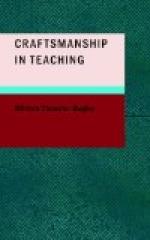He taught this school for two years. He had no supervision. He read various books on the science and art of teaching and upon a certain subject that went by the name of psychology, but he could see no connection between what these books told him and the tasks that he had to face. Finally he bought a book that was advertised as indispensable to young teachers. The first words of the opening paragraph were these: “Teacher, if you know it all, don’t read this book.” The young man threw the volume in the fire. He had no desire to profit by the teaching of an author who began his instruction with an insult. From that time until he left the school, he never opened a book on educational theory.
His first year passed off with what appeared to be the most encouraging success. He talked to his pupils on science and literature and history. They were very good children, and they listened attentively. When he tired of talking, he set the pupils to writing in their copy books, while he thought of more things to talk about. He covered a great deal of ground that first year. Scarcely a field of human knowledge was left untouched. His pupils were duly informed about the plants and rocks and trees, about the planets and constellations, about atoms and molecules and the laws of motion, about digestion and respiration and the wonders of the nervous system, about Shakespeare and Dickens and George Eliot. And his pupils were very much interested in it all. Their faces had that glow of interest, that look of wonderment and absorption, that you get sometimes when you tell a little four-year-old the story of the three bears. He never had any troubles of discipline, because he never asked his pupils to do anything that they did not wish to do. There were six pupils in his “chart class.” They were anxious to learn to read, and three of them did learn. Their mothers taught them at home. The other three were still learning at the end of the second year. He concluded that they had been “born short,” but he liked them and they liked him. He did not teach his pupils spelling or writing. If they learned these things they learned them without his aid, and it is safe to say that they did not learn them in any significant measure. He did not like arithmetic, and so he just touched on it now and then for the sake of appearances.
This teacher was elected for the following year at a handsome increase of salary. He took this to mean a hearty indorsement of his methods; consequently he followed the same general plan the next year. He had told his pupils about everything that he knew, so he started over again, much to their delight. He left at the close of the year, amidst general lamentation. School-teaching was a delightful occupation, but he had mastered the art, and now he wished to attack something that was really difficult. He would study law. It is no part of the story that he did not. Neither is it part of the story that his successor had a very hard time getting that school straightened out; in fact, I believe it required three or four successive successors to make even an impression.




